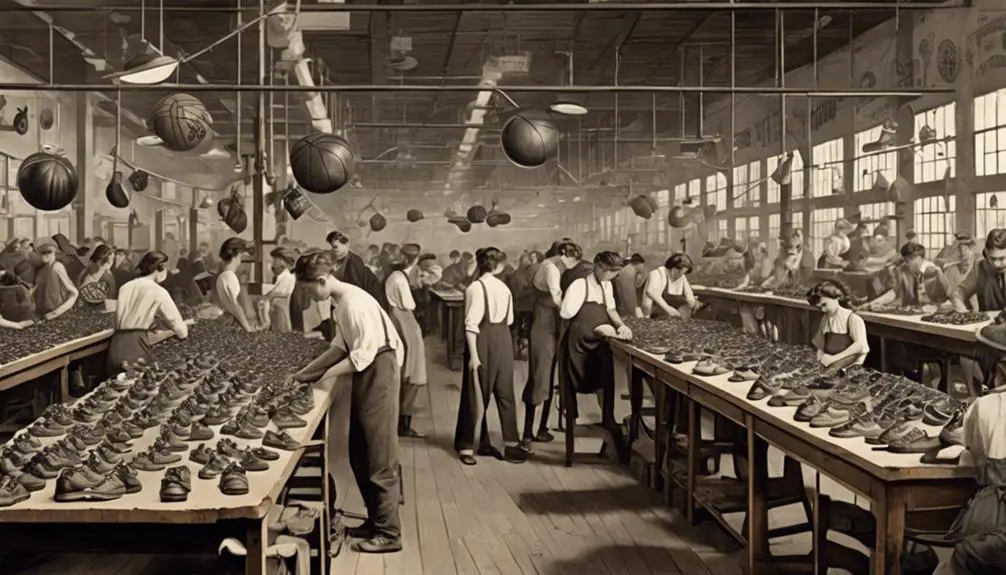Converse was founded in February 1908 by Marquis Mills Converse in Malden, Massachusetts. It started out making rubber-soled shoes, focusing on functional footwear for various sports. The company gained momentum with the launch of its first tennis shoe in 1910 and the iconic Chuck Taylor All-Star basketball shoe in 1917. Chuck Taylor himself joined the company in 1921, revolutionizing its marketing strategies and helping the shoe become a cultural icon. Over the years, Converse has faced challenges but adapted and thrived, becoming a staple in both sports and fashion. Keep exploring to uncover more about its fascinating journey!
Founding of Converse

In the early 1900s, Converse was born out of Marquis Mills Converse's vision in February 1908, right in Malden, Massachusetts. He initially focused on creating rubber-soled shoes for various sports, laying the groundwork for what would become a giant in athletic footwear.
The company's first product was galoshes, but it didn't stop there. Soon, Converse expanded its offerings to include tennis shoes, demonstrating a commitment to innovation in sports footwear.
In 1917, Converse took a significant leap forward by introducing the All-Star basketball shoe. This marked the first mass-produced basketball shoe in North America, setting the stage for Converse's future success.
The All-Star became synonymous with basketball, but it wasn't until Chuck Taylor joined the company in 1921 that its design and marketing truly evolved. Taylor's influence helped the shoe gain immense popularity, turning it into a cultural icon that resonates with sports fans and fashion enthusiasts alike.
Early Product Development
Following the successful introduction of the All-Star basketball shoe, Converse continued to innovate and expand its product line. Founded in 1908 as a rubber shoe company, Converse originally focused on creating functional athletic footwear, particularly notable for its first mass-produced basketball shoe that would dominate the market.
Their first product, a rubber-soled shoe for tennis, made its debut in 1910. This early success laid the groundwork for Converse's reputation in the industry.
In 1917, Converse took a significant leap by launching the Chuck Taylor All-Star basketball shoe. This shoe wasn't just another athletic footwear option; it became the first mass-produced basketball shoe in North America, perfectly timed with the sport's rising popularity.
The All-Star's design was further refined in 1922 at Chuck Taylor's request, leading to the inclusion of his signature on the shoe. This brand endorsement played a vital role in enhancing its market appeal, making it a favorite among players and fans alike.
Chuck Taylor's Influence
Chuck Taylor's impact on Converse and the basketball shoe industry is undeniable. When he joined Converse in 1921, he didn't just sell shoes; he revolutionized the way they were marketed. His insights into design and promotion helped shape Converse into a leading basketball brand.
One of his most significant contributions was introducing basketball clinics as a promotional strategy. These clinics not only showcased Converse shoes but also engaged young athletes and schools, enhancing the brand's visibility.
In 1932, Chuck's name and signature were added to the All-Star logo, forging a powerful connection between the product and its ambassador. This move elevated the Chuck Taylor All-Star to become the first celebrity-endorsed athletic shoe.
His influence didn't stop there; he played an essential role in developing the iconic white high-top model worn by the U.S. Olympic basketball team in 1963. This association with elite performance solidified the shoe's reputation in the sports world.
Thanks to Taylor's efforts, the Chuck Taylor All-Star gained tremendous popularity among players and fans alike. It became more than just a shoe; it was a symbol of basketball culture.
Challenges and Acquisitions
Throughout its history, Converse has faced numerous challenges that tested the brand's resilience and adaptability. Founded in 1908 by Marquis Mills Converse, the company initially focused on creating rubber-soled shoes for sports. As Converse evolved into the athletic footwear market, it became synonymous with basketball culture, especially after the launch of the All-Star in 1917.
However, over the years, it encountered significant financial hurdles, culminating in bankruptcy in 2001. This setback could have spelled disaster, but instead, it led to a turning point when Converse was acquired by Footwear Acquisitions. This acquisition laid the groundwork for a remarkable revival.
In July 2003, Converse took another major step when it was purchased by Nike for around $305 million. This acquisition proved vital, as it allowed Converse to tap into Nike's extensive global distribution and marketing capabilities. With these resources, Converse started to reclaim its place in the footwear market.
By 2012, the brand reported a staggering $450 million in revenue, primarily driven by the iconic Chuck Taylor line. This resurgence was further supported by the brand's adaptation to contemporary fashion trends, as seen in the evolution of the Converse logo and its appeal to collectors.
Fast forward to 2023, and Converse generated an impressive $2.4 billion in revenue, showcasing its significant resurgence and ongoing relevance in both athletic and casual footwear markets. Despite the trials of bankruptcy and shifts in ownership, Converse's ability to adapt and innovate has solidified its standing in the industry.
The brand's journey emphasizes the importance of resilience and strategic partnerships, proving that even in the face of challenges, success is achievable.
Cultural Impact and Legacy

Converse has undeniably left a profound mark on culture, transcending its origins as a sports shoe brand to become a symbol of youth rebellion and authenticity. The Chuck Taylor All-Stars, introduced by the Converse Rubber Shoe Company, emerged as a cultural icon especially in the post-WWII era. These shoes became staples for various subcultures, including punk rock and skate communities, representing a bold statement against conformity.
You've probably noticed that the All-Stars have appeared in over 650 films and TV shows, solidifying their status as a fashion statement and a cultural touchstone across generations. Their ability to adapt and stay relevant is largely due to innovative collaborations with artists, designers, and cultural figures. These partnerships have allowed Converse to maintain its appeal in contemporary fashion trends while still celebrating its rich heritage.
Moreover, Converse's philanthropic initiatives, like the 1Hund (RED) collection, showcase its commitment to social responsibility and community engagement, further enhancing its legacy. This focus on giving back resonates with many consumers, fostering a deeper connection between the brand and its loyal fans.
Today, Converse generates over $2.3 billion in revenue, highlighting its sustained popularity and lasting impact on the fashion and athletic footwear markets. Through its unique blend of style, culture, and social initiatives, Converse continues to inspire, making it more than just a shoe—it's a movement that echoes youth rebellion and authenticity across the globe.




